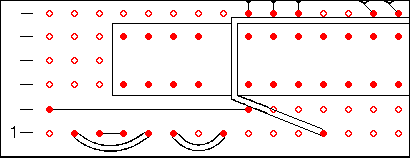Issue 3, May 1984 - Letters
| Home | Contents | KwikPik |
THE HEAVENS OPENThank you for the copy of your latest issue of Your Spectrum and the QL User supplement.Obviously, we welcome this sort of support for the new machine and hope we can reciprocate by getting large numbers into users hands very quickly. With best wishes for the success of QL User. Nigel Searle, Managing Director, Sinclair Research, Cambridge Thanks also to Sir Clive himself who wrote us a letter saying he found the mag "very interesting". Praise indeed! Ed.
SOME SPECCYS 'AVE ADAMRegarding the Spectrum Keyboard Buffer article in the Jan 84 issue, my problems and comments are as follows.Fault: I have built the buffer with the intention of using it as a joystick buffer by replacing the IC socket with a screwed connector block. Connecting up individual address lines and data lines singly, both by using a shorting link at the common line and a switch connection from a Commodore joystick, I get correct key operation. When I connect up the common line of the joystick to A12 and the four positional switch lines to D1 to D4 inclusive, I get no reaction at all but the copyright is OK, etc, and the keyboard works if I disconnect all but one data line, then the joystick operation in that direction will operate the Spectrum. Comment: on construction I found that in your illustration of the veroboard and connection you have linked pins 3 and 4 on the keyboard connector, ie. the 5v to the 9v. This, I think, could be very expensive for the Spectrum owner. Yes? Simply as a suggestion, would it not be a good idea on any reprints to name the lines shown coming away from the 74LS245 central connections? I would be obliged if you could solve this problem. Mr Crasley, Basildon Apologies! The circuit diagram given in my article was slightly wrong. Pin 14 at the end of the gate should have been labelled Pin 12. There should have been no connection between the IC socket and Pin 7. The two unlabelled lines are +5Sv and 0v (0v connected to Pin 7). The new veroboard straps are shown in the diagram. Any circuit should be checked before connecting to |
PLAYING HARD TO GETI refer to the program, Showdown, in the Play Power section of your first issue.Half-way through the program, you comment that the keyboard routine may not work on the new issue 3 Spectrums. As people typing in the program will have spent some time at the keyboard by the time they reach line 190 (and probably have no idea which issue Spectrum they have anyway!) that perhaps was not the best place to break the bad news. However, the program will work with the issue 3 models if the value of the IN command is changed from 255 to 191. On other occasions, when converting programs using the IN statement for the issue 3 Spectrum, you may like to refer to the following list (the IN command values are followed by the altered values for the Issue 3 in brackets): 255(191), 254(190), 253(189), 251(187), 247(183), 239(175). RP Taylor, Cheshire
OUT OF THE CLOSET ...I wonder if I could use the letters section of your magazine to make an appeal to your readers? (Be my guest. Ed.) I am involved with an ILEA Saturday school project in Brighton. As part of our activities I run a computer group, and although we have access to three Spectrums, we desperately need more facilities. There must be a number of people who have discarded their ZX80s and ZX81s to cupboards having bought Spectrums. Perhaps some of these people would be willing to loan or donate such unused micros, as the funding for the project is very low. If anyone can help could they please contact me.Stephen Oxford, Senior Teacher, Highbury Fields School, Highbury Hill, London N5 1AR |
WAKE UP AT THE BACK!Quick! Print this before our MD breaks out of his cage and does something drastic! What am I talking about? Well, actually it's about the review of our ADS Centronics interface that you ran in your last edition. Your reviewer states that our manual needed reading two or three times to glean all the available info. I guess he's right, because he obviously didn't.His parting shot at our little protege was "superb unit, but slightly let down by the provision of supporting high resolution dump software for only one range of printers". Mmm, interesting one that. You see, when we sat down and started looking at what kind of software we should supply with the unit, we sussed out the competition and sure enough, we saw that they provided separate dump routines for each type of printer. "Hey, what if we could produce a dump routine that runs on all printers, with the minimum of alteration?" says wily MD. "No problem" replies resident genius, result - a routine that is adaptable for all printers, using just a few (well documented) POKEs. Yes, YS, our unit will only support one range of printers - dot matrix ones. Come on you reviewers, at least read the instructions first and give us poor designers a break, eh? Martin Flenley, Software Designer, Advanced Digital Systems Ltd, Portsmouth
IT ALL ADDS UPI have to say that I'm amazed at the first prize in the Ant Attack competition.I got out my trusty calculator and worked out that the prize is worth over £7000. With that sort of money you could buy an Apple IIe, disks, a printer, a modem and still have enough money left over for software and electricity bills. Iain Radford, Derbyshire Good thinking . but why on earth would you want an Apple??! Ed
RESTEZ REGULIERI was agreeably pleased to read, during my Christmas holidays in England, issue 1 of Your Spectrum.I appreciate the versatility of the articles and games descriptions, etc. In a phrase "Pour un coup d'essai ce fut un coup de maitre". (Er, right. Ed.) Congratulations! However, I was surprised by the lack of a subscriptions voucher. Will you be including one in future issues? ER Boulad, Courbevoie, France Details of how to subscribe to Your Spectrum are included in this issue. Ed.
WHAT'S THE CONNECTION?In the January issue of Your Spectrum, the article about the Currah MicroSpeech unit, Talk to me, Oh MicroSpeech, | ||||||||||

The corrected straps for the veroboard used to construct the keyboard interface as published in the article Spectrum Keyboard Buffer in YS issue one. | ||||||||||||
|
stated that the
unit was compatible with the
printer and so "there's no
worry about being unable to
list out hard copies of
programs while the
MicroSpeech is in use".
Could you please explain how the printer and the MicroSpeech can be used together, because the Currah unit requires a full-size edge connector, and does not have its own edge connector (to facilitate further expansion), and the printer has a ZX81- size connector? David Wooding, Cardiff Okay, we blew it. More Humble Pie, anyone? Ed.

MISTAKE!?!Did anyone else notice the mistake on the cover of Your Spectrum issue 2? The QL photo had the 'L' and 'W' keys swapped.J Jack, Rochester Don't let our photography department hear you say it was a mistake - it took them ages to mess about with the keyboard! Ed. |
CLOCK THATFurther to the Clock This program (issue 2), I have re-written the alarm routine as, after much thought, I consider the whole screen turning red to be unsatisfactory. Instead, the border still turns red and a two-toned BEEP sounds for 20 seconds - a bit more like an alarm. (The new listing is shown alongside.)Ian Turtle, Loughborough
DO THE CONTINENTALI've read your first issue and found a great many interesting features, for example, Debugit, Go Faster, Moving Graphics and Sir Clive (if only for the excellent picture). I also very much liked all the machine code you were able to include.I did notice, though, that you were missing a letters page and an exhibition list. Also, despite your lack of a club page I would like to tell you a little of our computer club. The Belgium User Group for Sinclair computers is a club which covers the Flemish speaking part of Belgium, and holds regular meetings in Antwerp, Brussels, Ghent, Kortrijk, Leuven and Hasselt. For more information on the club's operation, you can call me on 03 449 4445 after 7pm (my time please) or else write to the address given below. P Ob de Beeck, Chairman BUGS, xxxxxxxxxx nnn, nnnn xxxxxxx, xxxxxxx Question: how can you publish reader's letters in a first issue? Answers on a postcard please, etc, etc. Ed. |
GOING WITH THE FLOWYour magazine fell into my hands quite by chance - it was the only copy left in the shop, surrounded by the usual selection of 'glossy' computer mags. Although already well- thumbed by the rising generation of computer buffs, I was only too pleased to part with my 95p.Your Spectrum is the type of magazine I've been looking for since I purchased my Spectrum 48K last February. I trust you will keep up the very high standards you have set yourselves. Thank you for the listings, which are clear, readable and well laid-out. Only one thing missing here (which no other magazine does anyway) and that is suitable flowcharts to accompany the programs. I know all you experts can do these programs standing on your head while sipping a pint and cracking walnuts between your fingers, but I'm sure there are many of us who would like more information - so that we can follow the reasoning of the program and perhaps even make our own modifications. Flowcharts would certainly help in this respect. W Jones, Kent It's an interesting idea. First thing though, we've got to make sure all our programs actually 'flow'. Ed. |
| ASSEMBLER | COMMENT | |
|---|---|---|
10 20 30 40 50 | CLOCK RST 56
DI
PUSH AF
PUSH BC
LD A,(65535)
| |
340 350 360 | ALARM LD A,2
CALL #229B
LD B,10
| Change BORDER colour Number of BEEPS in alarm |
370 380 390 400 410 420 430 440 450 460 470 480 490 500 510 520 | LI PUSH BC
LD A,1
CALL #2D28
LD A,20
CALL #2D28
CALL #03F8
LD A,1
CALL #2D28
LD A,25
CALL #2D28
CALL #03F8
POP BC
DJNZ LI
LD A,62
LD I,A
IM 1
| Save B from overwriting Load A with length of note Put A on calculator stack Load A with pitch and place on calculator stack Call BEEP routine Second BEEP note Recover B and complete note As before, except extra POP BC |
530 540 550 560 | END POP BC
POP AF
EI
RET
| |
10 CLS: CLEAR 65119: RESTORE 300 15 PRINT TAB 4;"Alarm Clock-I.D.Turtle";TAB 5; FLASH 1;"Loading machine code" 20 LET sum=0: LET i=1 30 READ a: IF a>255 THEN GO TO 50 40 LET sum=sum+a: POKE 65119+i,a: LET i=i+1: GO TO 30 50 IF sum<>a THEN GO TO 200 60 LET sum=0: LET i=1 70 READ a: IF a>255 THEN GO TO 90 80 LET sum=sum+a: POKE 65128+i,a: LET i=i+1: GO TO 70 90 IF sum<>a THEN GO TO 200 100 INPUT "Hours?";h: POKE 65532,h 110 INPUT "Mins?";m: POKE 65533,m 130 POKE 65534,0 140 POKE 65535,0 150 PRINT ''"Don't forget to"'' INVERSE 1;"RANDOMIZE USR 65120" 160 PAUSE 200 170 NEW 200 PRINT "Error": LIST 9999: STOP 300 DATA 62,9,237,71,237,94,201,911 310 DATA 255,243,245,197,58,255,255,254,0,40,6,61,50,255,255,24,97,62,49,50,255 320 DATA 255,58,254,255,254,0,40,6,61,50,254,255,24,79,62,59,50,254,255,58 330 DATA 253,255,254,0,40,6,61,50,253,255,24,61,62,59,50,253,255,58,252,255 340 DATA 254,0,40,6,61,50,252,255,24,43,62,2,205,155,34 350 DATA 6,10,197,62,1,205,40,45,62,20,205,40,45,205,248,3,62,1,205,40,45,62,25 351 DATA 205,40,45,205,248,3,193,16,226 360 DATA 62,62,237,71,237,86,193,241,251,201,14404 | ||
| Ian Turtle's re-worked listing for Clock This - the assembler listing is given at the top of the page for your guidance. | ||
| Home | Contents | KwikPik |